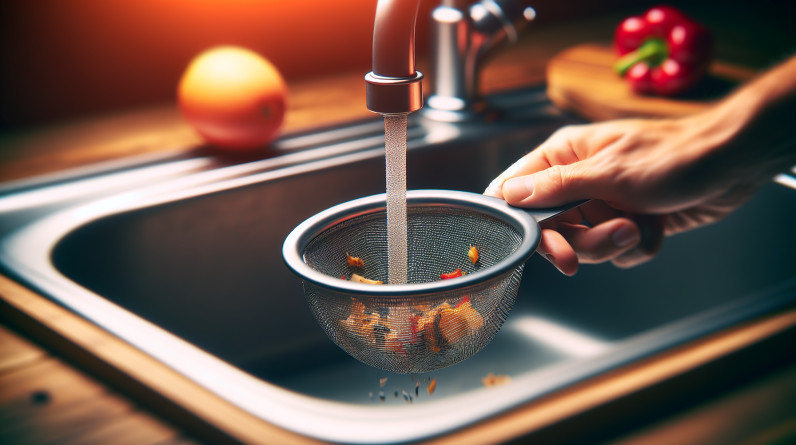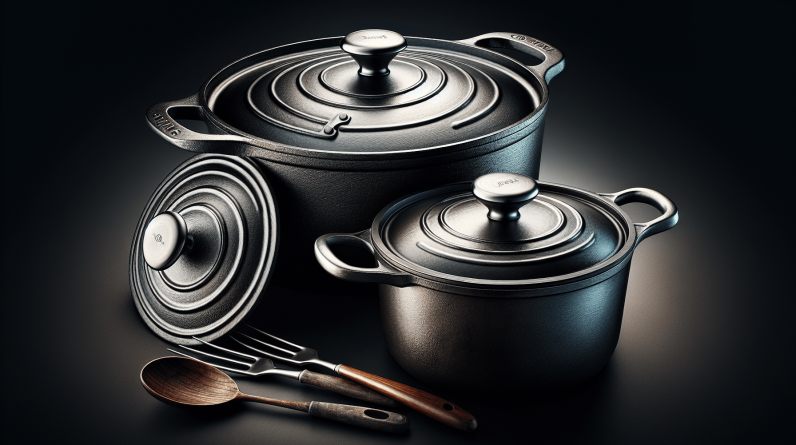Properly storing sharp knives is essential for both safety and longevity. In this article, we explore the correct method to store sharp knives, ensuring they are easily accessible while reducing the risk of accidental injuries. Whether you’re a professional chef or a home cook, implementing these storage techniques will not only keep your knives in top condition but also provide peace of mind in your kitchen. So, let’s dive in and discover the optimal way to store your sharp knives, keeping them conveniently at hand while ensuring everyone’s safety.

Importance of Proper Knife Storage
Proper knife storage is essential for several reasons. Not only does it prevent injuries, but it also extends the lifespan of your knives and ensures they remain sharp. By investing in the right storage options and following some general guidelines, you can create a safe and organized kitchen environment while maintaining the quality of your knives.
Prevents Injuries
One of the primary reasons why proper knife storage is crucial is to prevent injuries. A sharp knife can cause severe damage if mishandled or accidentally grabbed. By storing your knives properly, you minimize the risk of accidents and keep your family and yourself safe. Imagine reaching into a drawer filled with loose knives – it’s a recipe for disaster! By adopting proper knife storage techniques, you eliminate the chance of accidental cuts and promote a safer kitchen environment.
Extends Knife Lifespan
Proper knife storage also plays a vital role in extending the lifespan of your knives. Knives are an investment, and taking care of them ensures they stay in excellent condition for years to come. When knives are stored haphazardly, they can get damaged or dulled, reducing their effectiveness and durability. So, by implementing proper storage techniques, you protect your investment and ensure that your knives remain in optimal condition.
Maintains Knife Sharpness
Maintaining the sharpness of your knives is essential for efficient and safe cutting. A dull knife requires more force to cut through food, increasing the risk of accidents. When knives are stored improperly, they can come into contact with other utensils or hard surfaces, causing them to chip or become dull. By storing your knives correctly, you preserve their sharpness and ensure that they perform optimally whenever you use them.
Choosing the Right Storage Options
Now that we understand the importance of proper knife storage, let’s explore some storage options available to us.
Knife Blocks
Knife blocks are a popular and versatile option for knife storage. These blocks typically consist of a wooden block with horizontal slots or compartments to hold the knives. They not only keep the knives organized and easily accessible but also protect the blades from damage. Knife blocks are a great choice for those who want their knives to be within reach on the kitchen countertop.
Magnetic Knife Strips
Magnetic knife strips provide a sleek and modern storage solution for your knives. These strips are usually made of stainless steel or wood, with strong magnets embedded in them. By simply attaching the knives to the magnetic strip, you can keep them visible, easily accessible, and safely stored. Magnetic knife strips are particularly useful if you have limited counter space or if you want to showcase your knife collection.
Knife Rolls or Bags
For those who value portability and organization, knife rolls or bags are an excellent storage option. These rolls are usually made of durable and easy-to-clean materials such as canvas or nylon. They feature fabric pockets or compartments to securely hold each knife and are often equipped with a tie or buckle to keep them tightly closed. Knife rolls or bags are ideal for chefs on the go or individuals who prefer to keep their knives safely tucked away when not in use.
Drawer Inserts
If you prefer to keep your knives neatly tucked away in a drawer, consider using a drawer insert specifically designed for knives. These inserts typically feature angled compartments or knife-holding slots, allowing you to securely store your knives and prevent them from moving around. By using a drawer insert, you can maximize the storage space in your kitchen while keeping your knives organized and protected.
General Knife Storage Guidelines
Regardless of the storage option you choose, there are general guidelines that should be followed to ensure the safe and proper storage of your knives.
Keep Knives Separate from Other Utensils
To prevent accidental cuts and damage to the blades, it is essential to keep your knives separate from other utensils. Mixing knives with other tools in a drawer can lead to blade chipping or dulling. It’s best to dedicate a specific area or storage method for your knives to keep them isolated and prevent unnecessary contact.
Avoid Stacking Knives
When storing knives, it is crucial to avoid stacking them on top of each other. Stacking knives can cause blades to rub against one another, leading to scratches and potential damage. If you must stack knives due to limited space, consider using protective sheaths or blade guards to minimize the risk of blade-to-blade contact.
Ensure Knives are Clean and Dry
Before storing your knives, it’s important to ensure they are clean and dry. Moisture can lead to rust or corrosion, damaging the blade’s integrity over time. After each use, thoroughly wash and dry your knives before returning them to their designated storage area. By keeping your knives clean and dry, you prolong their lifespan and maintain peak performance.
Never Store Knives Loose in Drawers
Storing knives loose in drawers is not only unsafe but also detrimental to the knives themselves. Loose knives can easily shift position and be difficult to find when needed, increasing the risk of accidental cuts. Additionally, loose knives can collide with other utensils, causing blades to chip or become dull. Always use appropriate storage methods, such as knife blocks, magnets, rolls, or drawer inserts, to keep your knives securely and safely stored.
Specific Knife Storage Techniques
Now that we have covered the general guidelines, let’s delve into specific knife storage techniques based on the different storage options mentioned earlier.
Using a Knife Block
If you opt for a knife block for storage, here’s how you can effectively use it. First, determine the appropriate slot for each knife based on its blade length and type. Slide the knives gently into their respective slots, ensuring they are aligned with the handle end. Avoid forcing knives into slots that are too small, as this can damage both the knife and the block. Regularly clean your knife block to prevent the buildup of dirt or bacteria.
Hanging Knives on a Magnetic Strip
For magnetic knife strips, start by installing the strip securely on a convenient and accessible location. Place the knives on the magnetic strip, ensuring the blades are securely attached. Avoid placing the knives too close together to prevent scratching or damage. Regularly clean the magnetic strip to remove any residue or dust that could accumulate.
Storing Knives in a Knife Roll or Bag
When using a knife roll or bag, open it up and lay it on a flat surface. Insert each knife into its designated pocket or compartment, ensuring the blade is fully covered and protected. Roll up the knife roll or securely close the bag using the provided tie or buckle. Store the knife roll or bag in a safe place, away from moisture or extreme temperatures.
Utilizing Drawer Inserts
To utilize a drawer insert for knife storage, first, ensure that the insert fits securely within your drawer. Insert each knife into its designated slot or compartment, aligning the blade with the guide to prevent movement. Close the drawer gently, ensuring the knives are securely held in place. Regularly clean the drawer insert to prevent the accumulation of food particles or dirt.

Additional Knife Storage Tips
Here are a few additional tips to help you optimize your knife storage and ensure the longevity of your blades:
Avoid Storing Knives in a Dishwasher
While it may be tempting to toss your knives in the dishwasher for convenience, this can be damaging to the blades. Dishwashers expose knives to the abrasive detergents, high heat, and movement that can lead to dulling, corrosion, or even handle damage. Wash knives by hand with warm, soapy water and dry them thoroughly before storage.
Consider Knife Guards or Blade Sleeves
To provide extra protection for your knives and minimize the risk of accidental cuts, consider investing in knife guards or blade sleeves. These accessories cover the blade when not in use, preventing contact with other objects and reducing the chance of injuries.
Regularly Inspect and Maintain Knife Storage
To ensure that your knife storage remains in optimal condition, make it a habit to regularly inspect and maintain your storage choices. Check for any signs of wear, damage, or dirt buildup that could compromise the safety and longevity of your knives. Clean and sanitize your storage options as needed to keep them free from bacteria or residue.
Educate Household Members about Proper Knife Handling
Proper knife storage is not just about the physical storage methods but also about educating your household members about the importance of safe knife handling. Teach them how to handle knives properly, to avoid leaving them lying around, and to always return them to their designated storage area after use. By instilling good habits and awareness, you create a safe environment for everyone in your home.
Creating a Safe Kitchen Environment
Knife storage is just one aspect of creating a safe kitchen environment. Here are a few additional considerations to enhance kitchen safety:
Designating a Dedicated Knife Storage Area
To avoid confusion and accidents, consider designating a specific area in your kitchen solely for knife storage. This could be a countertop space, a mounted magnetic strip, or a dedicated drawer. By having a designated area, you and your family will always know where to find and return the knives, reducing the risk of injuries.
Keeping Knives Out of Reach of Children
Children are naturally curious and may be attracted to the shiny blades of knives. To keep them safe, store knives in a location out of their reach. Ensure that the storage method you choose is child-resistant or install childproof locks on drawers or cabinets where knives are kept.
Minimizing Clutter in the Kitchen
A cluttered kitchen can contribute to accidents, especially when it comes to knives. Keep countertops and food preparation areas clear of unnecessary clutter to create a more organized and safer environment. By minimizing the number of objects in your kitchen, you reduce the chances of accidentally knocking a knife off the counter or causing a hazardous situation.
Installing Safety Measures
Consider installing additional safety measures in your kitchen to prevent accidents. This could include childproof locks, blade guards on drawers, or safety locks on cabinets. By taking proactive steps to enhance kitchen safety, you create a more secure environment for you and your family.

Maintaining Knife Sharpness
Proper knife storage is essential for maintaining the sharpness of your blades. Here are some tips to keep your knives sharp and ready for use:
Using a Honing Steel
Regularly using a honing steel can help maintain the sharpness of your knives. A honing steel is a long, narrow rod that is used to realign the knife’s blade edge. By running the edge of the blade against the honing steel at a slight angle, you can keep your knife in peak condition between sharpenings. Incorporate honing into your regular knife maintenance routine to ensure optimal sharpness.
Sharpening Knives Properly
While honing helps maintain the knife’s sharpness, occasional sharpening is necessary to restore a dull blade. Invest in a high-quality knife sharpener or consider having your knives professionally sharpened when needed. Follow the manufacturer’s instructions when sharpening your knives or seek professional guidance to avoid damaging the blades.
Avoiding Excessive Use on Hard Surfaces
To preserve the sharpness of your knives, avoid excessive use on hard surfaces such as glass, ceramic, or metal. These surfaces can dull the blade quickly and cause premature damage. Instead, opt for cutting boards made of wood, bamboo, or plastic to provide a softer surface that is gentler on your knives.
Safe Handling and Usage of Knives
Properly handling and using knives is equally important to ensure both your safety and the longevity of your blades. Consider the following tips when working with knives:
Properly Holding and Gripping Knives
Hold the knife firmly but not too tightly, allowing for precise control while reducing the risk of accidental cuts. Use a pinch grip – where your thumb and index finger grip the blade just above the handle – for better control and stability. Avoid gripping the knife by the handle alone, as this can result in less control and potentially lead to accidents.
Cutting Techniques and Knife Skills
Learn and practice proper cutting techniques and knife skills to enhance safety and efficiency in the kitchen. The proper technique can prevent accidents and ensure consistent results. Invest time in learning various cutting methods, such as the rocking motion for chopping or the slicing motion for delicate cuts. Proper knife skills not only improve safety but also enhance your culinary prowess.
Using Cutting Boards
Always use a cutting board when working with knives. Cutting directly on countertops or other surfaces can damage both the blade and the surface itself. Choose a cutting board that is large enough to accommodate your food comfortably and opt for materials that are knife-friendly, such as wood, bamboo, or plastic. Avoid using glass or ceramic cutting boards, as they can dull your knives quickly.
Cleaning Knives Safely
When cleaning your knives, always handle them with care to avoid accidents. Wash knives by hand using warm, soapy water, ensuring that you clean both the blade and the handle. Never leave knives submerged in water or allow them to soak for extended periods, as this can lead to rust or corrosion. After washing, thoroughly dry the knives with a soft cloth or towel to prevent moisture buildup.
Choosing the Right Knife for the Task
Selecting the right knife for a particular task ensures efficient and safe food preparation. Here are a few considerations when choosing a knife:
Understanding Knife Types
Familiarize yourself with different knife types to understand their specific uses and benefits. Common types include chef’s knives, utility knives, paring knives, bread knives, and boning knives. Each knife is designed for specific tasks, so having a variety in your kitchen allows you to tackle any culinary challenge with ease.
Matching the Knife to the Food or Ingredient
Consider the food or ingredient you will be working with and choose the appropriate knife accordingly. For example, a chef’s knife is versatile and suitable for a wide range of tasks, while a serrated bread knife is perfect for slicing through crusty loaves without crushing the delicate interior. Matching the knife to the food ensures better precision, safety, and overall cooking experience.
Considerations for Specialty Knives
For those who enjoy more specialized cooking techniques or working with particular ingredients, consider investing in specialty knives. Examples include a filleting knife for precision fish preparation or a cleaver for cutting through bones. Specialty knives provide enhanced control, efficiency, and safety for specific culinary endeavors.
Professional Knife Storage Recommendations
Professional chefs and commercial kitchens often have specific guidelines in place for knife storage. Here are a few recommendations from the professionals:
Knife Storage in Commercial Kitchens
In a fast-paced commercial kitchen setting, knife storage needs to be efficient and accessible. Many professional kitchens opt for magnetic knife strips mounted on the wall for quick and easy access. Knife rolls or bags are also popular options, allowing chefs to carry their culinary tools with them wherever they go.
Best Practices from Professional Chefs
Professional chefs emphasize the importance of cleanliness and organization when it comes to knife storage. They recommend cleaning and drying knives after each use, using designated storage areas or methods to avoid cross-contamination, and keeping the knives sharp for optimal performance. Regular maintenance and inspection are practiced to ensure that the knives remain in excellent condition.
Commercial Knife Storage Solutions
For commercial kitchens with large quantities of knives, there are specialized knife storage solutions available. These solutions often include knife blocks with multiple compartments, drawer inserts with customizable slots, or even automated systems that provide secure and organized storage. These commercial options promote efficiency, safety, and ease of access in busy kitchen environments.
In conclusion, proper knife storage is essential for ensuring safety, extending the lifespan of your knives, and maintaining their sharpness. By choosing the right storage options, following general guidelines, and implementing specific storage techniques, you can create a safe and organized kitchen environment while maximizing the value of your blades. Remember to regularly inspect and maintain your storage choices, educate others about proper knife handling, and consider additional safety measures to enhance kitchen safety. By adopting safe handling practices, regularly maintaining your knives, choosing the right knife for the task, and considering professional recommendations, you can enjoy the benefits of sharp and reliable knives in your culinary adventures.










